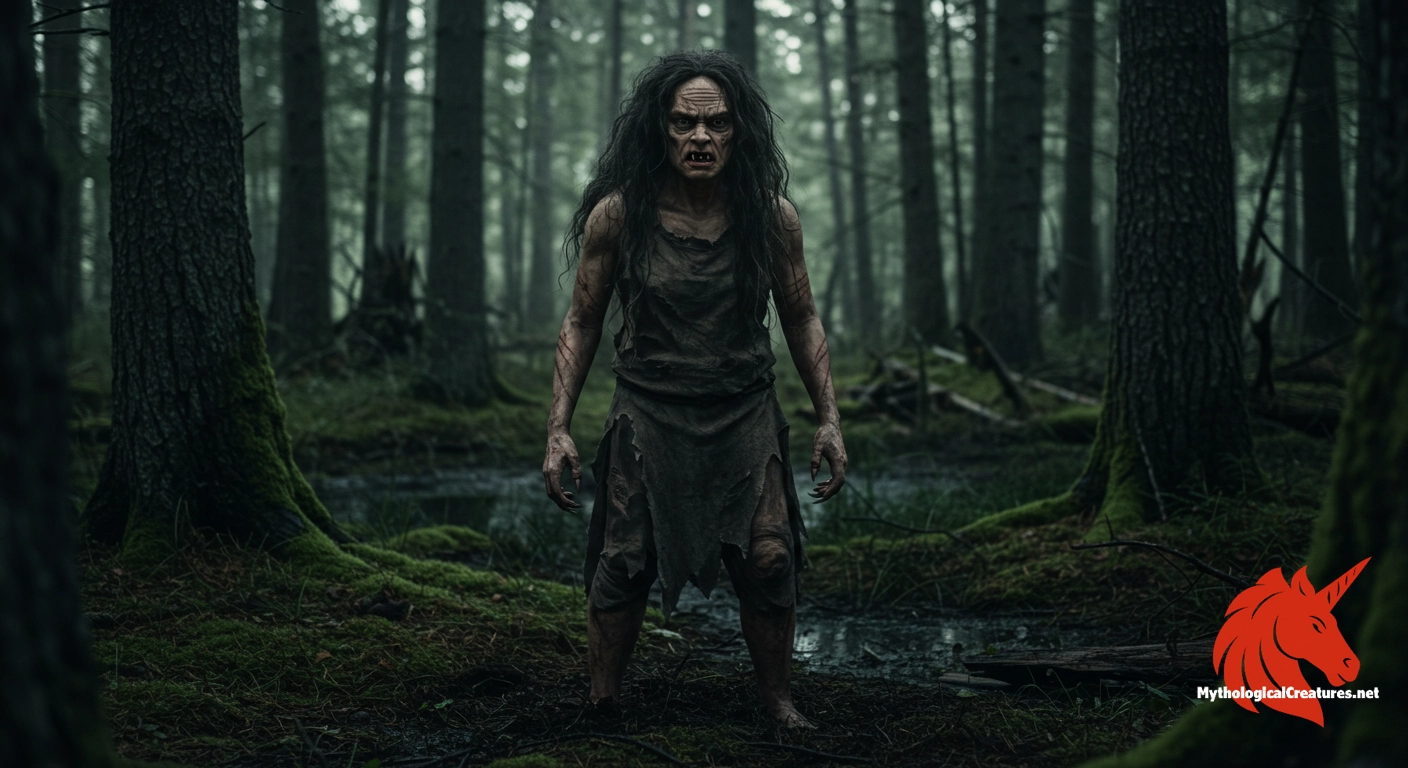Syöjätär: Syöjätär, also known as the eateress, is a fearsome ogress from Finnish folklore.

Syöjätär
Syöjätär - Represents the enigmatic origins of diseases and the manifestation of societal fears through monstrous and disruptive natural elements.
Origins & First Encounters
Syöjätär is a complex figure emerging from Finnish folklore, its legacy interwoven with themes of chaos, disease, and maternal dread. Her name, literally meaning 'eateress', evokes an image of a monstrous female being, both feared and mystifying. Born from the rich traditions of Finnish oral storytelling, her presence has long been associated with the origins of various ailments and misfortunes. She is often depicted as a formidable, otherworldly force whose actions upset the balance between health and decay. In narratives that have travelled through generations, she embodies the darker aspects of nature, serving as a cautionary emblem of uncontrolled forces. While early attestations of her myth appear in local folktales, her character has grown richer and more nuanced over time. The interplay between her roles as devourer and wicked mother offers insights into the ambivalence of feminine power in myth. Her tale signifies the struggle between the nurturing and destructive potentials of nature, making her not merely a monster, but a symbol of the unpredictable wild. Her enduring image has been maintained through the layers of superstition and poetic metaphor that define Finnish cultural memory. This multifaceted persona resonates deeply with themes of mortality and transformation in natural cycles.
Source Texts & Tale Variants
Ancient references to Syöjätär can primarily be traced through oral traditions and regional folktales, where her character is interlaced with themes of disease and monstrosity. Stories handed down by generations speak of her role in summoning misfortune and manifesting unnatural creatures like snakes, lizards, and wolves. While many accounts originate from a shared Finnish heritage, her mythological presence appears sporadically in early compiled manuscripts and folklore anthologies. Variants of her tale have been woven into the fabric of everyday living, serving not only as entertainment but also as moral and cautionary lessons. Some accounts emphasise her role as a brutal matriarch, a figure whose very existence disrupts natural order. Other versions portray her more shadowily, leaving her exact motives and origins ambiguous, which has only added to her mythical allure. The multiplicity of sources underlines the tendency of folk narratives to evolve and adapt over time. As a result, the primary literary records of Syöjätär are as varied as they are enigmatic, inviting continuous reinterpretation and debate. Her story remains a testament to the rich and mutable tradition of Finnish myth-making. In every telling, the layers of her tale hint at deeper symbolic meanings that challenge simple categorisation.
Form & Powers
The physical form of Syöjätär is as enigmatic as her character, often described in a blend of stark human traits and otherworldly deformity. Artistic renditions and narrative descriptions portray her as possessing an unsettling countenance marked by exaggerated features that blur the lines between human and monster. Her visage might be imagined with sunken eyes, a gaunt face, and an expression that reflects an endless hunger, symbolising the consumption of life and vitality. Some folklore accounts describe her with elongated limbs and a disjointed body that appears to twist unnaturally, emphasising her divergence from normal human form. The recurring mention of her as an 'ogress' hints at the large, imposing stature and the grotesque quality of her appearance. Variations in depictions also suggest the possibility of changing forms—sometimes a hideous hag, other times a spectral figure shrouded in darkness. The portrayal of her may include elements such as wild, unkempt hair and a pallid, almost diseased complexion that mirrors her association with illness. In some interpretations, the physical distortions serve as allegorical reflections of decay and the corruption of nature. Her appearance perpetuates the idea that beauty and nurturance are both entwined with danger, reinforcing cultural cautionary tales. These visual representations collectively forge a multifaceted image that is as memorable as it is terrifying.
Regional Faces
Regional variations of the Syöjätär legend reveal a tapestry of local colour and subtle shifts in her characterisation. In rural areas of Finland, where the isolation of wilderness heightened the mystique of the unknown, she is often portrayed as a solitary figure with connections to the natural and supernatural realms alike. By contrast, in certain eastern Finnish regions, communal narratives accentuate her role as a harbinger of disease and as a symbol of nature’s more malevolent forces. In some village accounts, her presence is intertwined with local agricultural cycles, transforming her into an omen whose appearance warns of impending crop failures or natural calamities. Areas with a deep history of shamanistic practices might incorporate rituals intended to ward off her influence, further embedding her into regional cultural practices. Variations in her representation also arise from the interplay between pagan beliefs and later Christian reinterpretations, resulting in a blend of sacrilegious and redemptive imagery. Local adaptations of her myth occasionally incorporate elements from neighbouring Scandinavian folklore, subtly altering her attributes and narrative role. Regional storytellers have enriched her legend by embedding specific natural landmarks or weather phenomena into her lore. This geographical diversity contributes to a living myth that evolves to reflect the varied experiences and environments of its narrators. As a result, Syöjätär remains a figure whose story diverges and converges across cultural and regional lines, continually reshaped by her listeners.
Cultural Parallels
The myth of Syöjätär finds intriguing parallels in a variety of cultural traditions, where the embodiment of dangerous, consuming femininity often recurs. Echoes of her predatory and disease-inflicting nature can be seen in numerous European legends, such as the ogres and hags that populate French and Slavic folklore. Much like her Finnish counterpart, the infamous figure of Baba Yaga in Slavic tales also exhibits ambiguity between wisdom and malevolence. Similar themes appear in the mythic depictions of monstrous maternal figures who both nurture life and precipitate its decay, creating a pervasive narrative tension. In Mediterranean cultures, figures with consuming appetites and transformative powers echo the dual symbolism of creation and destruction attributed to Syöjätär. The dual nature of these characters often reflects a broader cultural ambivalence towards the role of women as both life-givers and potential sources of chaos. Comparative analysis reveals that many cultures use such figures as emblematic representations of uncontrollable natural forces. These cross-cultural connections highlight an enduring human fascination with the dynamics of power, vulnerability, and the mysteries of life’s cyclical processes. Across different mythological landscapes, Syöjätär and her counterparts prompt audiences to confront the unsettling reality that beauty and nurture can be inextricably linked to decay and peril. Thus, her narrative resonates on a universal level despite the specificity of her Finnish origins.
Legacy & Modern Evolution
Over the centuries, the legacy of Syöjätär has undergone a transformation that mirrors the evolving worldview of Finnish society. While once conceived as a literal embodiment of disease and decay, her image has gradually acquired layers of metaphorical significance in modern retellings. Contemporary reinterpretations often cast her as a symbol of environmental degradation and the uncontrollable forces of nature in an increasingly industrialised world. Modern literature, visual arts, and even digital media have found in her a resonant allegory for the invasive nature of unbridled consumption and chaos. The stark contrasts in her portrayal—from a fearsome ogress to a tragic figure representing nature’s wrath—demonstrate how myths can shift in tone and meaning over time. Scholars and artists alike appreciate her as a multifaceted icon, whose legacy is subject to reinterpretation in light of modern challenges. As such, contemporary cultural works sometimes reposition her as a misunderstood antihero or a cautionary symbol against ecological collapse. Public exhibitions and folklore festivals in Finland occasionally highlight her legend, drawing connections between ancient traditions and current social issues. This enduring evolution underscores the power of myth to adapt and survive across epochs. In essence, Syöjätär remains a potent figure whose legacy continues to inspire critical reflection on the interplay between nature, culture, and human frailty.
Interesting Fact
Syöjätär exemplifies how folklore personifies abstract fears, transforming them into tangible, monstrous figures.
Quick Creature Info
Origin:
Features:
Our Mythic Legendary Rating:

Also Sometimes Known As:
Habitat:
Supernatural Powers:
Physical Attributes:
Abilities:
Behavior:
Lore:
Related Creatures, Tales or Lore
- LLoviatar
- BBaba Yaga
- GGrendel's Mother
References
Discover Another Mythical Legend You May Not Have Heard Of?
Uncover the mysteries of ancient folklore and expand your knowledge of legendary beings from cultures around the world.
Dare to Meet the Numushda....
Curated by the Mythological Creatures Team (rev. May 2025)
